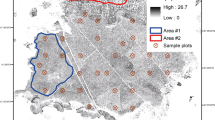Abstract
Forest trees harvesting is an important component of the forest resources management process. However, it causes several ecological damage on the forest ecosystem. Thus, approaches for automating or aiding the trees harvesting activities are essential to reduce damage and to ensure a sustainable management of the forest ecosystem. Moreover, an efficient and low-cost trees harvesting is financially important, as it is likely to impact the profitability of a particular management plan. This paper describes a spatial optimization approach to include ecological constraints in scheduling directions for harvesting trees using GIS based techniques. We present an experiment on real data in the forest of “Montagne Tortue” in French Guiana.
Preview
Unable to display preview. Download preview PDF.
Similar content being viewed by others
References
Anderson DJ, Bare BB (1994) A dynamic programming algorithm for optimization of uneven-aged forest stands. Canadian Journal of Forest Research. vol 24, pp 1758–1765
Baskent EZ (1990) Spatial wood supply modeling: concept and practice. M.Sc.F. Thesis, University of New Brunswick. Fredericton, NB
Baskent EZ, Jordan JA (1995) Designing forest management to control spatial structure of landscapes. Landscape and Urban Planning, vol 34, pp 55–74
Carver SJ (1991) Integrating multi-criteria evaluation with geographical information systems, Geographic Information System. vol 5, pp 321–339
Clements SE, Dallain PL, Jamnick MS (1990) An operational spatially constrained harvest scheduling model. Canadian Journal of Forest Research. vol 20, pp 1438–1447
Goodchild, MF, Parks BO, Steyaert LT (1993) Environmental modelling with GIS. Oxford University Press, New York
Grumbine RE (1994) What is ecosystem management? Conserv. Biol. 8. pp 27–38
Jankowski P (1995) Integrating geographical information systems and multiple criteria decision making methods, Geo. Inform. Sys. vol 9, pp 251–273
Johnson KN, Scheurman HL (1977) Techniques for prescribing optimal timber harvest and investment under different objectives, discussion and synthesis. Forest Science. vol 23, pp 1–31
Jones JG, Meneghin BJ, Kirby MW (1991) Formulating adjacency constraints in linear optimization models for scheduling projects in tactical planning. Forest Science. vol 37, pp 1283–1297
O’hara AJ, Faaland BH, Hare BB (1989) Spatially constrained timber harvest scheduling. Canadian Journal of Forest Research 19, pp 715–724
Roise JP (1990) Multicriteria Nonlinear Programming for Optimal Spatial Allocation of Stands. Forest Science, vol 36, pp 487–501
Thompson WA, Weetman GF (1995) Decision support systems for silviculture planning in Canada. The Forestry Chronicle, vol 71, pp 291–298
Weintraub A, Jones G, Meacham M, Magendzo A, Magendzo A, Malchuk D (1995) Heuristic procedures for solving mixed integer harvest scheduling transportation planning models. Canadian Journal of Forest Research, vol 25, pp 1618–1626
Yoshimoto A, Brodie JD, Sessions J (1994) A new heuristic to solve spatially constrained long-term harvest scheduling problems. Forest Science, vol 40, pp 365–396
Author information
Authors and Affiliations
Editor information
Editors and Affiliations
Rights and permissions
Copyright information
© 2007 Springer-Verlag Berlin Heidelberg
About this paper
Cite this paper
Jaziri, W. (2007). Finding Optimal Directions for Forest Trees Harvesting Using GIS-based Techniques. In: Gómez, J.M., Sonnenschein, M., Müller, M., Welsch, H., Rautenstrauch, C. (eds) Information Technologies in Environmental Engineering. Environmental Science and Engineering. Springer, Berlin, Heidelberg. https://doi.org/10.1007/978-3-540-71335-7_46
Download citation
DOI: https://doi.org/10.1007/978-3-540-71335-7_46
Publisher Name: Springer, Berlin, Heidelberg
Print ISBN: 978-3-540-71334-0
Online ISBN: 978-3-540-71335-7
eBook Packages: Earth and Environmental ScienceEarth and Environmental Science (R0)




